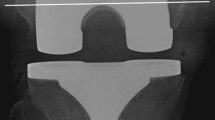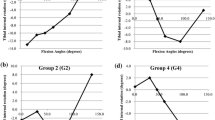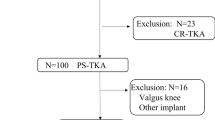Abstract
Purpose
To analyze the incidence of intraoperative mid-flexion laxity using continuous flexion-arc gap assessment, risk factors for mid-flexion laxity, and clinical results in navigation-assisted total knee arthroplasty (TKA).
Methods
Ninety posterior-stabilized TKAs were performed under navigation guidance for patients with degenerative arthritis and varus deformity. Intraoperatively, the gap between the trial femoral component and insert was evaluated in the navigation system with continuous flexion-arc gap assessment. Each medial and lateral gap at flexion (90°) and extension (0°) were made to be less than 3 mm. Mid-flexion laxity was determined when the gap in the flexion range between 15° and 60° was 3 mm or more. The proportion of knees with mid-flexion laxity was investigated. The factors affecting mid-flexion laxity were identified in terms of demographics, preoperative convergence angle, and change in joint line height and posterior femoral offset. The Knee Society Score and Western Ontario and McMaster Universities Osteoarthritis Index were evaluated.
Results
There were 31 cases (34.4%) of lateral mid-flexion laxity (average peak mid-flexion gap = 3.7 mm). The other 59 cases did not show mid-flexion laxity. The preoperative convergence angle was the only significant factor affecting lateral mid-flexion laxity (odds ratio = 1.466, p = 0.002). There were no significant differences in the clinical results between the groups with and without mid-flexion laxity.
Conclusions
The continuous flexion-arc gap assessment was useful in evaluating mid-flexion laxity using navigation-assisted TKA. The preoperative convergence angle, reflecting soft-tissue laxity, can be a practical and simple radiographic finding for predicting lateral mid-flexion laxity.
Level of evidence
IV.




Similar content being viewed by others
References
Arnout N, Victor J, Chevalier A, Bellemans J, Verstraete MA (2020) Muscle loaded stability reflects ligament-based stability in TKA: a cadaveric study. Knee Surg Sports Traumatol Arthrosc. https://doi.org/10.1007/s00167-020-06329-2
Athwal KK, Willinger L, Manning W, Deehan D, Amis AA (2021) A constrained-condylar fixed-bearing total knee arthroplasty is stabilised by the medial soft tissues. Knee Surg Sports Traumatol Arthrosc 29(2):659–667
Bae DK, Song SJ, Park CH, Ko YW, Lee H (2017) A comparison of the medium-term results of total knee arthroplasty using computer-assisted and conventional techniques to treat patients with extraarticular femoral deformities. J Arthroplasty 32(1):71–78
BRAINLAB. KNEE3 SURGICAL TECHNIQUE. 2016. https://www.brainlab.com/wp-content/uploads/2016/12/Knee3-Surgical-Technique.pdf. Accessed 26 Jan 2021.
Cabuk H, Imren Y, Tekin AC, Dedeoglu SS, Gurbuz H (2018) High varus angle and lower posterior tibial slope associated with PCL injury in cruciate retaining total knee arthroplasty: an MRI study. J Knee Surg 31(3):277–283
Cyr AJ, Maletsky LP (2014) Unified quantification of variation in passive knee joint constraint. Proc Inst Mech Eng H 228(5):494–500
Cyr AJ, Shalhoub SS, Fitzwater FG, Ferris LA, Maletsky LP (2015) Mapping of contributions from collateral ligaments to overall knee joint constraint: an experimental cadaveric study. J Biomech Eng 137(6):061006
Graichen H, Lekkreusuwan K, Eller K, Grau T, Hirschmann MT, Scior W (2021) A single type of varus knee does not exist: morphotyping and gap analysis in varus OA. Knee Surg Sports Traumatol Arthrosc. https://doi.org/10.1007/s00167-021-06688-4
Healy WL, Della Valle CJ, Iorio R, Berend KR, Cushner FD, Dalury DF et al (2013) Complications of total knee arthroplasty: standardized list and definitions of the Knee Society. Clin Orthop Relat Res 471(1):215–220
Hino K, Ishimaru M, Iseki Y, Watanabe S, Onishi Y, Miura H (2013) Mid-flexion laxity is greater after posterior-stabilised total knee replacement than with cruciate-retaining procedures: a computer navigation study. Bone Jt J 95-B(4):493–497
Hino K, Kutsuna T, Oonishi Y, Watamori K, Kiyomatsu H, Iseki Y et al (2017) Assessment of the midflexion rotational laxity in posterior-stabilized total knee arthroplasty. Knee Surg Sports Traumatol Arthrosc 25(11):3495–3500
Incavo SJ, Schmid S, Sreenivas K, Ismaily S, Noble PC (2013) Total knee arthroplasty using anatomic alignment can produce mid-flexion laxity. Clin Biomech (Bristol, Avon) 28(4):429–435
Lee HW, Song SJ, Bae DK, Park CH (2019) The influence of computer-assisted surgery experience on the accuracy and precision of the postoperative mechanical axis during computer-assisted lateral closing-wedge high tibial osteotomy. Knee Surg Relat Res 31(1):15
Longo UG, Candela V, Pirato F, Hirschmann MT, Becker R, Denaro V (2020) Midflexion instability in total knee arthroplasty: a systematic review. Knee Surg Sports Traumatol Arthrosc. https://doi.org/10.1007/s00167-020-05909-6
Matsumoto T, Muratsu H, Kawakami Y, Takayama K, Ishida K, Matsushita T et al (2014) Soft-tissue balancing in total knee arthroplasty: cruciate-retaining versus posterior-stabilised, and measured-resection versus gap technique. Int Orthop 38(3):531–537
Matziolis G, Brodt S, Windisch C, Roehner E (2017) Changes of posterior condylar offset results in midflexion instability in single-radius total knee arthroplasty. Arch Orthop Trauma Surg 137(5):713–717
Minoda Y, Nakagawa S, Sugama R, Ikawa T, Noguchi T, Hirakawa M et al (2014) Intraoperative assessment of midflexion laxity in total knee prosthesis. Knee 21(4):810–814
Minoda Y, Sugama R, Ohta Y, Ueyama H, Takemura S, Nakamura H (2020) Joint line elevation is not associated with mid-flexion laxity in patients with varus osteoarthritis after total knee arthroplasty. Knee Surg Sports Traumatol Arthrosc 28(10):3226–3231
Minoda Y, Watanabe K, Iwaki H, Takahashi S, Fukui M, Nakamura H (2013) Theoretical risk of anterior femoral cortex notching in total knee arthroplasty using a navigation system. J Arthroplasty 28(9):1533–1537
Murer M, Falkowski AL, Hirschmann A, Amsler F, Hirschmann MT (2021) Threshold values for stress radiographs in unstable knees after total knee arthroplasty. Knee Surg Sports Traumatol Arthrosc 29(2):422–428
Na YG, Lee BK, Choi JU, Lee BH, Sim JA (2021) Change of joint-line convergence angle should be considered for accurate alignment correction in high tibial osteotomy. Knee Surg Relat Res 33(1):4
Okamoto S, Okazaki K, Mitsuyasu H, Matsuda S, Iwamoto Y (2013) Lateral soft tissue laxity increases but medial laxity does not contract with varus deformity in total knee arthroplasty. Clin Orthop Relat Res 471(4):1334–1342
Park CH, Kang SG, Bae DK, Song SJ (2019) Mid-term clinical and radiological results do not differ between fixed- and mobile-bearing total knee arthroplasty using titanium-nitride-coated posterior-stabilized prostheses: a prospective randomized controlled trial. Knee Surg Sports Traumatol Arthrosc 27(4):1165–1173
Shah MR, Patel JP, Patel CR (2020) Optimal flexion for the femoral component in TKR: a study of angle between mechanical axis and distal anatomic intramedullary axis using 3D reconstructed CT scans in 407 osteoarthritic knees studied in India. Indian J Orthop 54(5):624–630
Shalhoub S, Moschetti WE, Dabuzhsky L, Jevsevar DS, Keggi JM, Plaskos C (2018) Laxity profiles in the native and replaced knee-application to robotic-assisted gap-balancing total knee arthroplasty. J Arthroplasty 33(9):3043–3048
Song SJ, Lee HW, Park CH (2020) A current prosthesis with a 1-mm thickness increment for polyethylene insert could result in fewer adjustments of posterior tibial slope in cruciate-retaining total knee arthroplasty. J Arthroplasty 35(11):3172–3179
Tanifuji O, Mochizuki T, Yamagiwa H, Sato T, Watanabe S, Hijikata H et al (2021) Comparison of post-operative three-dimensional and two-dimensional evaluation of component position for total knee arthroplasty. Knee Surg Relat Res 33(1):21
Te Molder MEM, Wymenga AB, Heesterbeek PJC (2019) Mid-flexion laxity in the asymptomatic native knee is predominantly present on the lateral side. Knee Surg Sports Traumatol Arthrosc 27(11):3614–3625
Vajapey SP, Pettit RJ, Li M, Chen AF, Spitzer AI, Glassman AH (2020) Risk factors for mid-flexion instability after total knee arthroplasty: a systematic review. J Arthroplasty 35(10):3046–3054
Vince K (2016) Mid-flexion instability after total knee arthroplasty: woolly thinking or a real concern? Bone Jt J 98-B(1 Suppl A):84–88
Yoon JR, Jeong HI, Oh KJ, Yang JH (2013) In vivo gap analysis in various knee flexion angles during navigation-assisted total knee arthroplasty. J Arthroplasty 28(10):1796–1800
Funding
No external funding was used.
Author information
Authors and Affiliations
Corresponding author
Ethics declarations
Conflict of interest
None.
Ethical approval
All procedures performed in the studies involving human participants were in accordance with the ethical standards of the institutional and national research committee and with the 1964 Helsinki declaration and its later amendments or comparable ethical standards. This study was approved by the Institutional Review Board of our hospital.
Additional information
Publisher's Note
Springer Nature remains neutral with regard to jurisdictional claims in published maps and institutional affiliations.
Rights and permissions
About this article
Cite this article
Song, S.J., Lee, H.W., Bae, D.K. et al. Mid-flexion laxity could be identified with continuous flexion-arc gap assessment in patients with a large preoperative convergence angle. Knee Surg Sports Traumatol Arthrosc 31, 1307–1315 (2023). https://doi.org/10.1007/s00167-021-06846-8
Received:
Accepted:
Published:
Issue Date:
DOI: https://doi.org/10.1007/s00167-021-06846-8




